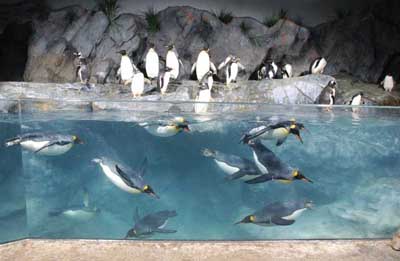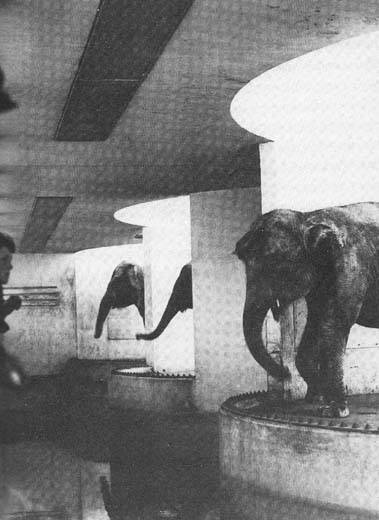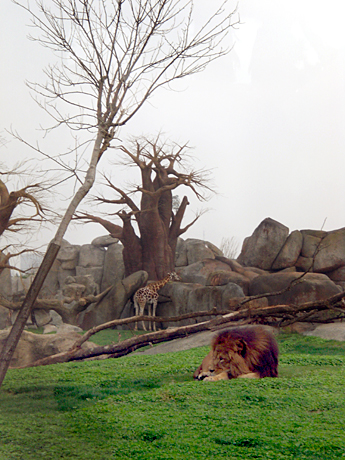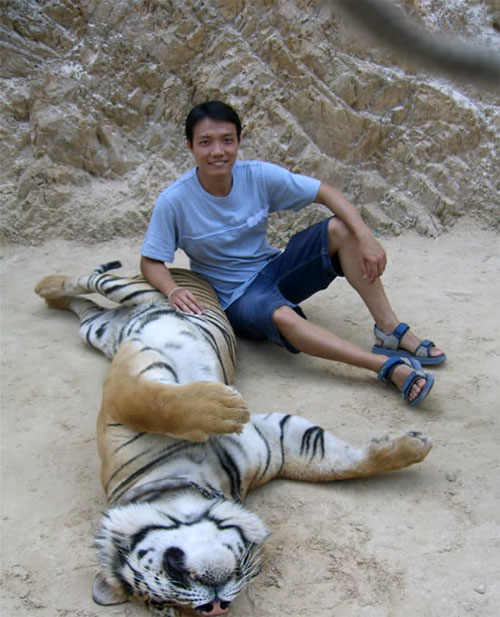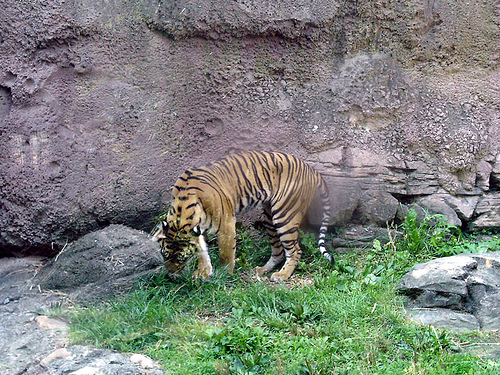For those following the conversation yesterday about the next big step in zoo design, I'm posting the article by Coe and Mendez that outlines his theory of the "Unzoo." Let me know what you think!
More Info on Bronx's Madagascar!
The lovely Ms. Sue Chin over at the Exhibits and Graphic Art Department at Bronx Zoo was kind enough to forward a couple of info sheets about the new Madagascar Exhibit. Instead of my summarizing for you, I am posting the sheets directly. The first outlines the exhibit itself, from a content and experience point of view:
MADAGASCAR! BRONX ZOO EXHIBIT FACT SHEET
HABITAT: Madagascar! represents a dazzling reproduction of intriguing habitats on the world's fourth largest island, located off Africa's east coast and will highlight the extraordinary array of Madagascar's wildlife and the many threats and challenges to species conservation. The exhibit will delight guests with a display of colorful and exotic creatures from this "eighth continent" and inspire a conservation ethic by illustrating the threats to the island's biodiversity and the urgent need for WCS and others to protect its wildlife and wild lands.
EXHIBITS:
Only In Madagascar This introductory exhibit to Madagascar! orients guests, through graphics and video, to the island's geography and distinctive assemblage of wildlife, the vast majority of which exist nowhere else. Animals Exhibited: pinstripe damba
Conservation Trail This path through the exhibit's rich interpretive experiences interweaves varied learning opportunities for guests to engage, both emotionally and intellectually, in the wonders of Madagascar and WCS's conservation activities.
Tsingy Cliffs This dramatic entrance gallery features spectacular limestone cliff formations extending a full two stories high, a striking habitat for Coquerel's sifaka, a critically endangered species of lemur that inhabits the northwest forests of Madagascar. Sifakas have a unique mode of locomotion-- called vertical clinging and leaping-where they use their powerful hind limbs to leap from tree to tree. Animals Exhibited: Coquerel's sifaka
Tsingy Caves Drawing guests deeper into the exotic world of Madagascar, the Tsingy Caves introduces one of the island's most dramatic habitats: an underground limestone cave created by the eroding effect of rivers and seeps over thousands of years. As guests navigate the dim passageway, they will come upon giant Nile crocodiles. Animals Exhibited: Malagasy killifish and Malagasy tree boa
Crocodile Pool Placed at eye level, a 15,000-gallon tank in the Tsingy Caves brings guests face-to-face with a 13-foot-long giant Nile crocodile lying in wait for its prey in the darkness of the cave.
Small Wonders, Big Threats This gallery introduces, at child's eye level, an array of living gems: tomato frogs, leaf-tailed geckos, rainbow fish and other fascinating creatures that introduce the diversity of Madagascar's wildlife. The exhibits is set into a high-tech surround "theater-in-the-round" with dramatic video portraying the island's animals in their native environments contrasted with scenes of habitat destruction and the threats to Madagascan wildlife. Animals Exhibited: mouse lemur, lesser hedgehog tenrec, Malagasy killifish, white fin rainbowfish, tomato frogs, Madagascar giant day gecko, golden mantella, painted mantella, blue-leg mantella, and leaf tailed gecko.
Spiny Forest In this gallery, the centerpiece of the exhibit, guests enter a bizarre arid forest of spiny trees found in Madagascar's dry south. There they encounter a diverse range of animals, including a dozen charismatic ring-tailed lemurs, a pair of brown lemurs, radiated tortoises, and two bird species: the Madagascar red fody and greyheaded lovebird. Animals Exhibited: ring-tailed lemur, brown lemur, gray-headed lovebird, Madagascar red fody, radiated tortoise.
Baobab Tree Within the Spiny Forest gallery, guests can step into a "cockroach tree," a fabrication of the oddly shaped baobab tree, where they will view a glass-enclosed collection of Madagascan hissing cockroaches. Animals Exhibited: hissing cockroaches Discovery Zone At the central point of the Conservation Trail, this child-focused interactive area provides an opportunity for hands-on exploration through educational activities designed to spark curiosity and foster learning in Madagascar!
Observation Station and Tortoise Nursery This interactive display brings guests inside a "WCS field hut" in the Spiny Forest for a close look at the science behind conservation. Here they can learn how scientists use observation of lemur behavior as part of conservation efforts in the wild. A pair of ring-tailed mongooses scamper around in this corner of the spiny forest, exploring their habitat. Guests can also view juvenile radiated tortoises, spider tortoises and two species of lizard. Animals Exhibited: ring-tailed lemur, ring-tailed mongoose, radiated tortoise, four-lined plated lizard, spiny-tailed iguana, spider tortoise (aka pixie tortoise)
Masoala A dramatic final gallery, here guests will experience a re-creation of the Masoala National Park, critically important to many of Madagascar's species and a site of WCS's field conservation efforts for more than a decade. A habitat formed around a cascading waterfall is home to a small group of vociferous red-ruffed lemurs, and a separate habitat hosts a pair of fossa, a unique mammalian predator found only on Madagascar. Animals Exhibited: red ruffed lemur, fossa
Fossa Forest Within the Masoala exhibit, guests will encounter a pair of animals rare in zoos. The fossa, the largest mammalian predator on Madagascar and a relative of the mongoose with catlike features, is one of the unique and threatened species of the island nation. Animals Exhibited: fossa
Masoala Cascade The Masoala gallery waterfall will flow into a 1,000-gallon elevated pool filled with colorful cichlids, unusual freshwater fish found in Madagascar. Animals Exhibited: spotted damba, red-sided damba, saro cichlid, fony cichlid
Conservation Pathway As guests depart Madagascar! and return to Astor Court, this pathway provides a final photographic opportunity in a reflective setting.
Great Hall Featuring the historic architectural elements of the building, this grand 4,600-square-foot multi-purpose room in the Lion House is the largest indoor meeting and event space at the Bronx Zoo. The refurbished century-old trusses, two-story windows and ornamental animal sculptures are visible to guests assembled for WCS meetings, community events and private functions in this flexible and fully accessible venue with a seating capacity of 230 people.
Executive Meeting Room This glass-enclosed meeting space within the Great Hall provides a bird's eye view of the dramatic architecture of the Lion House, including a close look at the interior sculptures and other historic architectural features. This upper level room affords a flexible space for use by WCS and community groups.
Lion Garden This courtyard along the west side of the Lion House enhances the historic architecture of the building's exterior. The sentinel lion sculptures, relocated from their original placement at the Lion House's south entrance, are the new focal points of the garden.
SIZE: Total Square Footage: 41,354 sq. ft. Basement: 20,765 sq. ft. First Floor: 18,648 sq. ft. Mezzanine: 1,941 sq. ft.
EXHIBIT DESIGN: Exhibition and Graphic Art Department, Wildlife Conservation Society Film and Video Production: Archipelago Films Media Design: Unified Field Bronze Sculpture: Priscilla Deichmann Life Support System Design: TJP Joel Johnson Illustration: Lawrence Richardson
ARCHITECTURE: Architect: FXFOWLE Architects, New York, NY Structural Engineer: Chris Anastos, P.E. Mechanical Electrical Plumbing (MEP) Engineer: Kallen & Lemelson Engineers Landscape Architect: Quennell Rothschild & Partners Historic Preservation: Building Conservation Associates, Inc. Lighting Consultant: Hayden McKay Lighting Design - Acoustic Consultant: Cerami Associates Geotechnical Engineer: Langan Engineers Code Consultant Expediter: Design 2147 Limited AV Consultant: DVI Communications Inc.
CONSTRUCTION: NYC Department of Design and Construction Construction Manager: Hill International
EXHIBIT CONTRACTORS: Habitat Fabrication: Cost of Wisconsin Graphics Fabrication: Dimensional Communications Inc Exhibit Murals - Dave Rock
The second is all about the project as an historic restoration and green project:
BRONX ZOO LION HOUSE RESTORATION
HISTORY The Wildlife Conservation Society has rededicated the spectacular architectural legacy of the Bronx Zoo's Lion House exhibit. The structure is over 100 years old, built in the popular French beaux-arts style of that era, an elaborate and highly decorative form that emphasizes dignity, symmetry and the infusion of diverse influences from the past. It is the largest of six buildings comprising the Bronx Zoo's Astor Court, and has served as the temporary home of the New York Aquarium, a meeting place for the National Guard during World War II, a home for the Zoo's big cat exhibit for many years and as the site where the groundbreaking 1905 decision was made to rescue America's rapidly-shrinking bison population.
Situated at the heart of the Zoo, the Lion House was designated a Historic District by the New York City Landmarks Commission in 2000 in recognition of its aesthetic and historic distinction. The 20,000-square-foot building, which opened in 1903, is a jewel of Beaux Arts architecture and will be the site of a magnificent new exhibit, Madagascar!, and of the Schiff Family Great Hall, a spacious community meeting and event facility. Its design addresses the functional demands of the future and incorporates new advances in animal welfare, visitor experience, conservation awareness, and science education. GREEN DESIGN It is anticipated that the building will carry the distinction of being the first landmarked building in New York City to be certified "green" by the U.S. Green Building Council. It represents the next generation of the Zoo experience, function as a publicly accessible building and exemplifies the Wildlife Conservation Society's mission of conservation - an integrated exploration of fit and form, aimed towards environmental, social, and economic sustainability. The greatest challenge was to design and restore a historic structure that not only met mixed use programmatic and functional goals, but also met the US Green Building Council's LEED (Leadership in Energy and Environmental Design) standards. An integration of sustainability into the design concept is the key to the success of all aspects of this project; a local materialization of the Wildlife Conservation Society's global conservation efforts and a model for future development. The contained, right-sized mechanical systems contribute to a healthy and sustainable environment for the animals, handlers and visitors with high standards of interior environmental quality These and many other sustainable advancements contribute to an anticipated LEED Gold Rating, including: Site • Site selection and building design are part of a comprehensive master plan. The building rehabilitation and its central location insure the use of a formerly empty building which had become obsolete for animal exhibits. • Maintain integrity of historic building and surrounding landmark district while incorporating modern exhibits and systems. • Cultural enhancement of the Bronx Zoo campus through historic preservation and creation of a new popular destination in a previously underused area. • Reinforce WCS mission for sustainability in a publicly visible area at the original center of the zoo complex.
Energy • Fuel cell for generation of building electricity with connection back into campus cogeneration system. • Use of waste heat to reduce size of building systems and connection to campus waste heat loop. • Geothermal heating and cooling systems to reduce consumption of fossil fuels. • Extensive use of dynamic skylight system to maximize daylight and modulate temperature in exhibits. • Increase acceptable temperature range within building to reduce equipment size. • The Lion House has a 57% savings in energy cost over an Energy Code compliant equivalent. Water • Use of waterless urinals and low flow plumbing fixtures to reduce water consumption for building occupant and public toilets used by thousands of visitors per day. • Wastewater reclamation through grey water system for lavatories. • Inclusion of water filtration system for adjacent sea lion pool to eliminate regular water changes. • The Lion House has a 59% savings in water consumption and 30% savings in waste water. Systems + Materials • Fully integrated building management system to control all aspects of the building environment. • Use of low-impact materials: recycled steel, slag concrete, FSC certified wood. • Use of high-performance building systems: ETFE dynamic skylight system to control sunlight and modulate heat loss and heat gain. • Location of construction within campus eliminates traffic impacts. • Construction waste management program to minimize waste generation, reuse materials and recycle waste. • Conservation of materials and resources: preservation of building shell; salvage and reuse of existing brick and stone to eliminate need for any new face brick. • Reduction in the building's ecological footprint (e.g. minimizing materials, space efficiency, limiting impact on the ecosystem.) Indoor Air Quality • Building Management system controls natural and mechanical ventilation as appropriate to interior and exterior temperature and humidity. • Operable windows and skylights. • Low pressure under-floor air distribution system. • Carbon dioxide sensors. • Use of low and no VOC emitting materials.
DESIGN Led by FXFOWLE Architects, a cadre of consultants expert at historic preservation, acoustics, green architectural practices, food services and event space use make up the team for the restoration. A complex design process included participants from landmarks and historic preservation, NYC Department of Design and Construction, NYC DDC Office of Sustainable Design, New York Power Authority and WCS's exhibit designers and plant and animal curators.
The core project goals were: to restore a historic structure; to adapt the architecture to address the new exhibit and event space program needs; and to meet the sustainable design principles that reflect WCS's mission. The Lion House required major infrastructure work to meet these goals.
The new program for the Lion House scope spans from cellar to ceiling, expanding the usable area from 32,000 to 41,000 square feet by increasing the basement in width and depth and by inserting an interior mezzanine. This program calls for the building to have two separate, but interconnected functions. The first function is as a dynamic animal exhibit dedicated to the beautifully exotic animal and plant life of Madagascar.
The second is the Schiff family Great Hall, a multi-use space that will host staff lectures, educational activities, art exhibitions, conservation conferences and other public events. The space will also be made available to the community for local needs such as Community Board meetings. Comprehensive restoration and cleaning of the brick façade, decorative friezes, limestone sculptures and wrought iron elements along with the replacement of the roof, downspouts and gutters, windows was necessary to return the building envelope to its original splendor. New Foiltec skylights retain the historic quality of the building yet address the needs of the new exhibit by allowing lots of natural daylight and ultra violet light for the animals and plants. Completely new HVAC, plumbing and electrical systems were designed to meet the complex needs of the animal exhibits as well as the Great Hall. A new geothermal system, along with a fuel cell funded by the New York Power Authority are prime examples of the green technology included in this project. The interior of the building required complex interior demolition, stabilization and replacement of floor structure, walls and building structure; and modifications to enable adaptive re-use for living collections. The landscape design includes an outdoor terrace to the west of the building. This terrace is the new home for the historic sentinel lions that were originally located at the South entrance to the building. In addition, the restoration includes installation of a fire protection system, the building of new service access, and the building complies with ADA requirements and general building and energy codes, including the installation of ADA compliant restrooms.
This construction project also includes two types of skylights. Traditional skylights have been installed over the corridors for visitors, public spaces and a mezzanine level conference room. WCS is also using a thermoplastic foil layering system called Foiltec for nearly 8,500 square feet of skylight space, which will balance the contradictory requirements of allowing maximum natural light with minimum heat gain. The Foiltec system has very good insulation value and uses special technology to connect to the HVAC for further temperature regulation efficiency. Foiltec is unique in that it transmits ultra violet light, which is vital to the animals and plant life in the Madagascar! exhibit. With this restoration, the Lion House returns to its earlier architectural glory, providing the public with an important destination for new exhibitions and educational program.
The Next Zoo Design Revolution?
Landscape immersion, which is a type of design intended to "immerse" the visitor in the same natural habitat as the animal, effectively began with the Woodland Park Zoo's gorilla exhibit. Created by zoo design godfathers Grant Jones and Jon Coe as a collaboration with Woodland Park then-director David Hancocks and biologist Dennis Paulson, they coined the term landscape immersion, and thus began the philosophical shift from a homocentric view of zoos to a biocentric view. We now spend massive amounts of resources re-creating "natural" places and cultural phenomena, in an effort to connect people to the earth; to inspire respect of natural places. Back in 1978, this style of design was fresh, new, innovative, revolutionary; nearly thirty years later, the style has become so a part of zoo culture that any exhibit not designed in this manner is questioned for its validity and chances of success. However, should landscape immersion continue to be our design standard? How do we push to the next step beyond landscape immersion?
True and successful landscape immersion requires designers to experience a habitat first-hand before beginning to design a re-creation of it. They research the essence of the habitat, the ecosystem structure within the habitat, and the natural ebbs and flows the habitat would undergo. The animal is an integral part of the ecosystem, not just the centerpiece of a painted scene. The visitor is whisked away to another world, drastically different from the asphalt sidewalks and ice cream shops of the zoo midway. Today's landscape immersion is, too often, not this. Today's landscape immersion usually means planting the visitor space with the same plants as seen in the animal exhibit, and using props from a culture as shade structures, means to hide back-of-house buildings, and educational interpretives. Moreover, today's visitor to a modern zoo no longer has their breath taken away by a landscape immersion exhibit; they simply expect to be immersed in an animal's habitat. The magic of landscape immersion is gone. Along with that, the opportunity to educate and inspire is waning, because, as Coe has said himself, "Only the emotional side, in the end, has the power to generate changes in behavior" (Powell, 1997). If the "oh my" moment is gone, does education stand a chance?
Landscape immersion does not generate longer experiences, as commonly believed. This can easily be shown true by simply observing visitor behavior at exhibits. After studying visitor length-of-stay time at viewing areas, little to no difference can be observed between the old, concrete moated tiger exhibit at Philadelphia Zoo and the landscape and cultural immersion tiger exhibit at Disney's Animal Kingdom. The average maximum stay time of 90 seconds has been consistently shown through observations at other exhibits as well, including the gorilla exhibit and bongo exhibit at Cincinnati Zoo, and the polar bear exhibits at Detroit Zoo and Louisville Zoo. Despite renovations and millions of dollars spent on landscape, rockwork, and interpretives, the most we can expect of our visitors is a minute and a half. Is this time shorter now than at immersion exhibits in the early 1980's? What can we do now to increase this time? Or, what can we do to get the most impact for our minute and a half?
One of the biggest complaints against landscape immersion is the difficulty, generally, in spotting and clearly seeing the animals. Therefore, proximity to animals should be a chief concern in exhibit design. Visitors want to experience something special. They want to do something no one else gets to do; something they have never done. Most importantly, in doing these things, visitors feel connected to the animals. Creating the connection should be of the utmost concern for designers and zoos.
Another component lacking in modern zoo design (not just landscape immersion specifically) is the integration of behavioral enrichment into the basic design process. Too often behavioral enrichment is an aspect of the exhibit that is not addressed by zoos to the architectural designer, even if the behavioral enrichment program is being developed concurrently. Most zoos still see the enrichment program as a separate aspect of the new exhibit to be implemented by the keepers after the exhibit is opened. Most architectural designers are ignorant to the importance of behavioral enrichment as a means not only to increase the health and welfare of the animal, but also in creating an active exhibit with active animals, which translates into longer stay times. Thus, enrichment generally is not addressed as an aspect of design, and ultimately we see beautiful new landscape immersion exhibits with large orange boomer balls and blue plastic barrels. Can these be considered cultural props? Recently, behavioral enrichment has been integrated beautifully into primate exhibits, but what about ungulates and big cats?
Connection creation and enrichment are the two most important issues that we must address in order to move beyond landscape immersion. The complexity of stepping beyond landscape immersion may seem a daunting task. However, the essence of the next successful step will be in creating "novelty"-something new or unexpected. Novelty to visitors, both within every new exhibit they encounter, as well as within the same exhibit upon repeat visits. We must create novelty to animals, both in new enrichment devices and methods, as well as within their own habitats. We need to make adaptable habitats that can be changed on a daily, weekly, monthly or seasonal basis. We need to make experiences for the visitor and animal that they can share, becoming intuitively novel, since every person or animal will react slightly different in new situations. Thus, our new exhibits will stay new, increasing visitor repeat attendance, and discouraging cookie cutter exhibit design.
But how do we begin to do this? In addressing the issues of connection creation and incorporation of enrichment into design, the first and most critical step will be to develop stronger relationships between architectural designers and zoo staff. Designers need to be educated by the keepers on animals' behaviors, both in the wild and in captivity, as well as on methods of behavioral enrichment. Designers should spend a day or two working side-by-side with the keepers as "keepers for a day." This will help designers to not only understand the needs of the keepers in their daily work routines, but also to help create bonds between designers and the animals whose homes they are creating. The zoo staff has a passion for animals that most architectural designers are lacking. This passion needs to be shared and experienced by the designers.
In "novelty-based" design, zoos and designers need to work together to develop new methods of enrichment and test them before integrating them into design. Design schedules and budgets should include a phase for enrichment development and testing, wherein the designers work with the keepers to create prototypes to be tested with the animals. If the zoo is designing exhibits for animals they currently do not have in collection, partnerships should be developed to test enrichment devices at other zoos with those animals. These findings should be recorded scientifically and published for the entire zoo community to share. If the zoo uses training as enrichment, the designers need to experience training sessions and clearly understand the need and utility of the training. Keepers and designers should be discussing how all of these methods can be displayed on exhibit.
Specific enrichment goals need to be addressed at design kick-off meetings, making numerical goals for incorporating enrichment devices and creating new methods. Enrichment must be seen as a philosophical aspect of design, incorporated into the master planning process, because if animals are active and happy, visitors will become more engaged. Enrichment must be planned not only for the opening day of the exhibit, but for the future of the exhibit as well. Animals become acclimated to enrichment devices and stop using them. We must plan for this, developing phasing plans for enrichment, and flexibility of the exhibit design for novelty of the environment. Most importantly, after the construction is complete, studies must be conducted to determine the successes and failures of enrichment techniques. These results should be shared with the zoo community, and especially, the designers.
Secondly, the "novelty-based" design process must become "connection-centered," not visitor-centered or animal-centered. Connections are created both by proximity and by experience. Landscape immersion began to explore this idea by attempting to have visitors and animals in the same habitat, thus experiencing the same things. However, in landscape immersion, we don't experience the same things at all. As visitors, we have a choice to move into a different area, to eat ice cream or hot dogs, to sit and watch the gorillas or to go see the penguins. We don't swim in the same water as the polar bears and we don't get to swing around on ropes like orangutans. What if we started creating these shared experiences? Can we make environments for animals and visitors that are truly similar? What if the actions of a visitor change the environment for the animal? What if the actions of an animal change the environment for the visitor? No longer would we be bound by the idea that the habitat must look like the animals' wild habitat. We could make it look like any thing, any place, any time, as long as the visitor and animal are engaged and ultimately, connected.
We have already seen a movement starting to push beyond landscape immersion, and, in some instances, toward "novelty-based" design. Several new exhibits, including the St. Louis Zoo ‘Penguin & Puffin Coast' exhibit and the San Francisco Zoo's ‘Lipman Family Lemur Forest', utilize natural habitat but also incorporate distinctly non-immersive elements, and are exceedingly successful. These exhibits focus on getting the visitor close to the animals (connection-centered) and being surrounded by active animals (behavioral understanding and enrichment incorporation). This experience, which will be different and therefore novel upon each visit, makes these exhibits extremely emotional and therefore memorable to visitors, and begins to create a connection. These exhibits are a step in the right direction toward "novelty-based" design. Using this type of design, we can move to the next incremental step in the evolution of landscape immersion, keeping the "oh my!" moment, and continuing to educate and inspire our zoo visitors.











Busch Gardens' Jungala Walk-thru
Recently, Busch Gardens' Africa's latest attraction, Junagala, opened to rave reviews. Check out the video preview from Orlando Attraction Magazine. [youtube=http://www.youtube.com/watch?v=dD_QTzSrVUk]
This new addition, conceptualized by Portico Group, includes a new large, lush habitat for the tigers and orangutans (not together!), and massive play structure for kids and adults, including several small sized rides. The purpose was to create interactivity between animals and people, and allow guests understand that all creatures play. In fact, the orangs play so well, that one has already found a way to escape, only to be lured back to her exhibit with ice cream!
The writers over at MiceAge, a site dedicated to the Disney parks, took time out to experience the attraction and write up a review. According to them, the attraction is a real win, and touches on the idea of enrichment-based design for guests and animals alike. Enjoy!











A Quick Lesson in Zoo Design History
Over time, zoos' physical forms have been a direct reflection of our society's values and understanding of science. It is important to understand where we've been in order to move forward, and its is also important for visitors to the older zoos to understand why certain buildings and exhibits are the way they are (as we know, zoos usually do not have an abundance of money, and struggle to keep their physical state up with the trends). Zoos, in the form we know them now, have been in existence since the mid-18th century. Prior to this, private collections existed throughout the world as far back, it is believed, to Mesopotamian times. Romans kept animals, of course, for sport, but would display the animals in a zoo-like manner, prior to their being released to their deaths in the Coliseum. But we'll focus on the mid-19th century forward.
We can easily divide the eras in zoo design into three general categories:
Zoos as Jails (mid 19th to late 19th century)
Zoos as Art Galleries OR the Modernist Movement (early to mid 20th century)
Zoos as Conservation and Education Facilities
Zoos as Jails
This was the Age of Enlightenment and the Romantic Age, where beauty was of the upmost value and our understanding of the natural world was blossoming into a science. Hard science in this time was all about classification and comparison. Linneaus and Darwin were the scientific stars. The earliest official zoos began during this period, with the London Zoo in 1828 and Philadelphia Zoo in 1874. The early zoos were based on the mission of science for science's sake, but also were places for socializing.
As such, a balance between beauty and classification was struck. The zoos of this time were laid out by taxonomic families, and the term "House" came into being, as in Cat House, Bird House, etc. The architectural style was over the top beautiful. Highly ornate bird cages and buildings themed in the most dramatic fashion were everywhere. But, cages were small, animals were short lived, and people enjoyed the animals as beautiful objects rather than living beings.
Zoos as Art Galleries OR the Modernist Movement
During this time, the world was experiencing several wars. The study of nature became much less important, but Romanticism still existed. Science progressed into problem solving, and medical advances were abundant. Vaccinations became prevalent and the idea of killing germs to increase health and extend life expectancy came into being.
During this time, zoos held a similar value as art galleries, and the exhibits became mini-paintings and sculptures. In the Romantic movement, a proper landscape exists with a foreground, mid-ground, and background. Carl Hagenbeck became the first-ever to apply this theory to zoo design resulting in the birth of the barless (or 'moated') exhibit. His motivation was more about creating a living Romantic landscape, like the famous painters of his time, than to recreate nature for moral sensitivities. This style started to catch on in zoos, but generally became popular much later.
At the same time, the modernist movement was catching fire. Modernism requires that form follow function. This belief along with the advances in medicine and desire for sterilization, created zoo exhibits that were easily hosed down and cleaned regularly. This meant concrete everywhere. Additionally, the Modernist Art scene infiltrated zoo design, and the hard, simple lines for which modernist style is famous, reigned supreme. The result was exhibits that look more like sculpture than habitat.
With both the Romanticism and Modernist styles abounding in this time period, zoo design was more about creating an art gallery than a responsible home for animals. Interestingly, due to the increased attention to health, captive animals' life expectancies did increase almost to today's levels. The only thing missing was attention to the animals' mental health.
Zoos as Conservation and Education Facilities
Since the mid-20th century, our society has developed a strong sense of environmental awareness and human rights ethics, which eventually gave way to animal rights as well. In 1950, Hediger wrote "Wild Animals in Captivity" which opened people's eyes to the idea of husbandry practices and exhibit design based on an animal's natural history. What a novel approach! With the advances in healthcare (which overlaps into this era), animals in captivity began to be treated for physical as well as mental health.
During the 1970s, a group of folks at the Woodland Park Zoo (including two young designers from Jones and Jones Architects) decided to resurrect Hagenbeck's ideas from long ago--and to advance them.
Instead of creating a living painting, they wanted to put the visitor into the habitat...Immerse them in the painting. And, instead of creating a visually exciting statement only, they decided to re-create the habitat in the which the animal was naturally seen. All of these things were incorporated into the gorilla exhibit at Woodland Park Zoo, and, thus, landscape immersion was born.
Since then, the idea of landscape immersion has caught on like wildfire, and today, is the standard of responsible zoo design. Understanding the past, I have to wonder where we are headed next...A topic for future discussion.
BioParc Valencia Opens
I have to admit that I'm a little behind on this one, but the new zoo in Valencia, Spain, called the BioParc, is now open. In fact, it opened early this spring, but thanks to an "also behind the times" mention in American Airlines' inflight magazine, I'm bringing it to you now.
Apparently, only phase one has been opened. This phase is focused entirely on Africa. Subsequent phases will include Southeast Asia and the Tropics (which, to me is one in the same, so I'm confused!). The park prides itself on the use of landscape immersion techniques, blurring the line of the animals' boundaries. One guest describes his experience eloquently here, including what sounds to be a pretty incredible walk-amongst-the-lemurs exhibit.
The park is approximately 25 acres (not sure if that is the final size or what is currently open), ticket price is 20 euros, and the collection is over 4000 animals strong. The ZooBeat forum outlines the current species on hand.
Unfortunately, the official website is in Espanol, and I know only a few words unlikely to be found on the site. Perhaps someone could help me out with some translation?











The Future of Science Based Institutions
The question of co-evolution amongst zoos, aquaria, and science museums has been a lingering muse for decades now. Back in 1986, Jon Coe cleverly equated the historical relationships to convergent evolution, and through his paper, which was more history lesson than predictor of the future, compared their similarities through time. Ultimately, he suggests "an awareness of others and ourselves, together with a willingness to communicate, can lead us further into an exciting co-evolution of zoo, aquariums and natural history museums." I'd like to take it a step further.
I often wonder why we separate all of our science institutions, dividing the natural world into equal, but succinct pieces: land animal (zoos), plant (botanical gardens), aquatic animal (aquaria), and the sciences (natural history museums and science centers). Of course, overlap occurs; zoos have fish and aquatic mammals, botanical gardens have butterfly houses, science museums have dioramas of the natural history of living creatures. Additionally, the method of teaching the general sciences varies greatly from conservative natural history museum approaches to more "fun" and interactive science centers.
As Coe mentioned, the teaming up of these institutions would be a powerful force. However, if, going beyond what Coe suggested, we created one institution that presented all of these disciplines, we'd be teaching holistically, presenting a unified view of the natural world that so many children and adults rarely get the chance to see.
The world has changed dramatically since the inception of these learning institutions. Most zoos and natural history museums began at the turn of the 19th century, when for the good majority of people, we still lived in a mostly untouched rurality. These people grew up with nature, lived in nature, or could easily visit nature, and learning about the natural world was most easily understood by the breaking down of components.
Today, however, most people live in cities or suburbs. Any nature we experience regularly is man-made or man-influenced, and certainly does not contain a wide variety of species or habitats. Learning about nature now becomes easier through an immersive, holistic approach. Add in society's constant bombardment with story driven entertainment and eye-candy, and learning almost requires the same treatment. Or so I postulate.
The Museum of Life and Science in Durham, North Carolina has already come to the same conclusion. Currently, they house live animals, present botanical displays, a natural wetland trail, and incorporate hands-on science center activities throughout. This is not enough for them, however.
We envision a one-of-a-kind place, a science park, offering extraordinary experiences indoors, outdoors, and virtual where children and adults learn through the pursuit of their own interests and curiosity. We will be recognized as the leader in public engagement with science in the Triangle region and as a model for science museums across the nation.
Will this be the future of science institutions? A one-stop shop, so to speak, for education and entertainment about the natural world? All things are intertwined; nature is a web of life. Why not present it that way?
Read the follow-up to this post: 'MULTI-DISCIPLINARY INTEGRATION...A MOUTHFUL OF FUN.'
Goodbye Elephants, Dallas Zoo Says
Dallas Zoo has become another in a long line of zoos ditching their elephant exhibits under the increasing pressure of animal activists. Their single female elephant, Jenny, will be going to the Africam Safari Park in Mexico. This decision has come after the second elephant living at the zoo, KeKe, passed away in May, leaving Jenny all alone. The AZA's standards suggest at least three females should be housed together.
The Zoo has announced plans for the defunct exhibit. They plan to expand their giraffe yard, and add more individuals, opening Spring 2009. Additional comments from the zoo elude to plans of bringing elephants back in the future, when the zoo can afford to build a more responsible home for them.
Activists oppose the move to the Safari Park, preferring a Tennessee sanctuary to an international park where U.S. standards of care do not have to be followed. The Zoo has inspected the facility, however, and feels the Safari Park is an excellent choice.
The Cute Factor
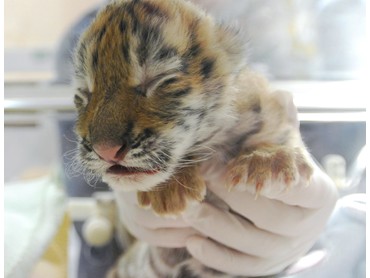 Zoo babies are a boon for visitor attendance. Most zoos have some kind of springtime zoo baby advertising festival, and can you blame them? Everyone wants to see that baby tiger before he grows up.
Here are just a few of the recent zoo babies making the news in the past couple of years from America and around the world. Enjoy!!
Zoo babies are a boon for visitor attendance. Most zoos have some kind of springtime zoo baby advertising festival, and can you blame them? Everyone wants to see that baby tiger before he grows up.
Here are just a few of the recent zoo babies making the news in the past couple of years from America and around the world. Enjoy!!
Unethical? Thailand's Tiger Temple
Thailand is touting a tiger temple where visitors can, once daily, walk amongst, pet, and be photographed with endangered animals, including tigers. The temple claims the tigers are tame, and are all the offspring from an orphaned group rescued years ago.
I won't deny the power of walking amongst these amazingly beautiful and powerful creatures, but where do we draw the line? Is petting a potentially dangerous animal truly beneficial to anyone beside the accountant at the temple?
And what of tameness via feeding the cats only cooked meat? Can this truly tame a big cat? I believe these cats can never truly be tamed, and I'm hesitant for anyone to work barrier free with the animals, not to mention letting uneducated visitors interact with them at will.
Plus, check out the photos. The cats look drugged, and definitely are chained up. Its a shame. And they call themselves a sanctuary.
Bear Behavior Captured!
A biologist studying bears for the past decade has captured hundreds of hours of grizzly bear behavior in Glacier National Park. This information is key to good bear exhibit design, as it allows us to understand the natural needs and instincts of these massive creatures.
Click here for video and article
Apparently, grizzly bears spend a lot of time rubbing their backs and heads on things, much like cats. This behavior is believed to be related to scent marking. Obviously, providing places for bears to do this in captivity will allow more natural behaviors to occur in front of the public, which is always entertaining and enlightening. 











Creating Happy Places...
Sometimes we forget why we do what we do. An article about Jane Goodall's new primate exhibit in Scotland reminded me. In response to outcry against primates in captivity (notably by singer Morissey), she states:
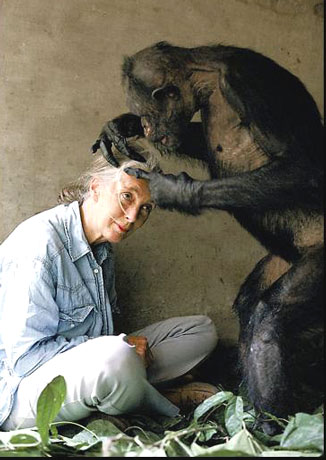 "In an ideal world chimpanzees and monkeys would be out in the wild as they were intended to be. But in the real world, there are not so many places like that and they are getting smaller all the time.
"In an ideal world chimpanzees and monkeys would be out in the wild as they were intended to be. But in the real world, there are not so many places like that and they are getting smaller all the time.
The choice is between living in wonderful facilities like these where they are probably better off or living the wild in an area like Budongo, where one in six gets caught in a wire snare, and countries like Congo, where chimpanzees, monkeys and gorillas are shot for food commercially. If I were a chimpanzee, I know what I would choose."
Powerful words that reminds me that we're not just creating memories for parents and children, but also providing a safe, enjoyable home for many of the world's displaced creatures.
And speaking of those memories, one San Diego Zoo visitor editorialized his recent experience at the Zoo, reminding us that, yes, zoos are about conservation and preservation, but sometimes we focus a bit too much on this aspect.
What does this mean to designers? I think it means we need to focus on a celebration of the critters who live in the homes we build.
Sometimes this means working with education departments to convince them that heavy messages aren't always the answer. Sometimes this means bringing entertainment into an exhibit. Sometimes this means making architecture less of a focus. Sometimes this means just making an exhibit about pure fun.
I hate to beat a dead horse (and, really, who does love doing that?), our job is to make animals interesting and alluring. Our guests need to walk away feeling empathy, feeling connection. Yes, facts are great, and knowledge is power. Call me jaded, but I'll be happy if one of those kids (or, hey, even better, one of those adults) walks out of an exhibit saying, Man, those guys are cool!











Louisville Opens Phase 2 of Glacier Run
As part of the concept team at PGAV that developed Glacier Run with Louisville Zoo, I am excitedly awaiting the opening of Phase 3 of Glacier Run--the Polar Bear, Sea Lion, Sea Otter, and Stellar's Sea Eagle exhibits. However, since phase 3 is still not under construction yet due to lack of funding (get on their webpage and donate people!), we'll have to enjoy the opening of a refurbished Siberian Tiger exhibit nearby the site.

Phase 1 of the exhibit area, a themed water play area, was opened last summer, and has since been packed with visitors daily. Phase 2, the tiger renovations, included updating the mid-century enclosure to be more visitor and keeper friendly. The old exhibit was uninviting, having 15' tall concrete walls all along the public walkway. The viewing area looked like a bunker. Now, the visitor area has been softened with pergolas and plantings. Training panels have been added so the public can get a first-hand view of the extensive behavioral training and enrichment the zoo conducts with its tigers.
In fact, Louisville Zoo is on the forefront of animal training and has a tradition of building enrichment and training opportunities into exhibits as a major component (see the Islands exhibit). The Zoo's philosophy is to turn the zoo "inside out" so all visitors can clearly see the extraordinary care given to the animals by the staff.
In Phase 3, you'll see much of the same. In concept development, the staff's first concern was to make the environment as complex and enriching as possible with the small amount of space available to the exhibit. This created not only a complex exhibit, but also a complex holding and enrichment facility with tunnels, stairs, a foraging room, and a maze of transfer chutes. In the final design, most of these elements made it, enriching not only the animals' lives but also the enhancing the experience for the visitors.
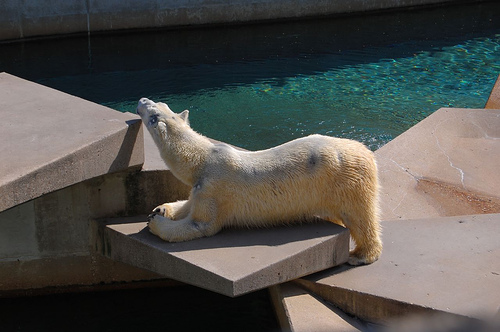 The new Glacier Run exhibit area will replace the current mid-century polar bear exhibit, and take over the adjacent hillside. The old exhibit was an excellent example of modernist design infiltrating zoos. The exhibit was more of a sculputural piece than a proper animal enclosure, and the animals were clearly affected. Stereotypy was seen, and animals rarely used their pool. The exhibit was entirely concrete with no natural substrates whatsoever. The new exhibit will be greatly appreciated by the bears.
The new Glacier Run exhibit area will replace the current mid-century polar bear exhibit, and take over the adjacent hillside. The old exhibit was an excellent example of modernist design infiltrating zoos. The exhibit was more of a sculputural piece than a proper animal enclosure, and the animals were clearly affected. Stereotypy was seen, and animals rarely used their pool. The exhibit was entirely concrete with no natural substrates whatsoever. The new exhibit will be greatly appreciated by the bears.
Check out the Louisville Zoo's Capital Campaign page for extensive information on the upcoming exhibit, and ways to contribute.
Enrichment Based Design, Revisited
Over ten years ago, Jon Coe wrote a paper outlining the upcoming breakthroughs in exhibit design, using enrichment based (or as he says, activity-based) design. These exhibits have now been opened and are successful. However, ten years from the original date of the paper, designers still have not fully embraced the design concept. Incorporating enrichment devices into an exhibit is one thing; to fully base design on enrichment or activity, is an entirely different animal. As Coe points out, however, design is not fully the designers' decision. A new animal habitat has many stakeholders, and even if the designer supports the idea of basing design on enrichment, the entire team of administrators, keepers, curators, and Board of Directors, not to mention all members of the design team, must also agree.
In many cases, the resources (of time, money, and/or space) just aren't there. Many times, the decision comes down to making an immersive environment or making an enriching environment. Unfortunately, many folks in the industry still hold onto the idea that an immersive environment equals animal health and activity, or at least, equal visitor satisfaction. However, active animals are much more powerful than a pretty environment, and we must work on our clients to understand this.
John Ball Zoo's New Lion Exhibit
John Ball Zoo in Grand Rapids, Michigan, opened a new $4 million lion exhibit, Lions of Lake Manyara, on June 14th. After several years without lions, the zoo has brought them back due to public demand for the beloved cats. Three lions, two female, one male, are now living in the large enclosure designed by Jones & Jones.
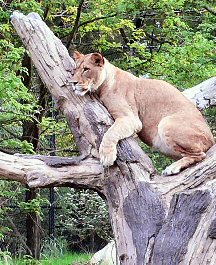 Taking lion behavior into consideration, the designers incorporated elements not normally seen in lion exhibits. Large areas of grass, natural trees and climbing rocks are seen throughout, plus a 30 foot tall artificial tree for climbing and lounging. The tree will be cooled and heated, as well as some of the rocks.
Taking lion behavior into consideration, the designers incorporated elements not normally seen in lion exhibits. Large areas of grass, natural trees and climbing rocks are seen throughout, plus a 30 foot tall artificial tree for climbing and lounging. The tree will be cooled and heated, as well as some of the rocks.
Historically, large cat exhibits have lacked interest and elements appealing to cats. Use of verticality for all types of cats is essential, and since most cats are daytime sleepers, providing unique perching and sleeping areas is key for both the cats and the visitors. With the opening of Philadelphia Zoo's Big Cat Falls last year, hopefully, this trend for revamping cat exhibits will catch on nationwide.
Omaha's Henry Doorly Zoo Poised to Expand
Henry Doorly Zoo is currently purchasing an adjacent site to increase the size of the zoo by nearly 36 acres. Incidentally, many urban zoos are less than 30 acres in total size, so this addition is a major add.

Plans were announced for $100 million in new exhibits...
- 950 additional parking spaces
- Madagascar Exhibit (a currently popular trend...see Bronx)
- Arctic Exhibit (another popular trend...polar bears)
- Adding Elephants (different as many zoos are deleting elephants from their collections)
- Possibly Giant Pandas
NC Zoo Opens Expanded Elephant Yard
Like Polar Bears, Elephants have been a hot topic for zoos in the recent past. Animal activists have started coming to the forefront, making alliances and friends of folks in power. In extreme cases, like the city of Chicago, pending legislation prohibits elephants to be kept in captivity, unless the institution meets unrealistic standards. In the case of Chicago, the new city ordinance would require 10 acres per elephant, of which, 5 acres are indoor. These requirements are intended to drive zoos and circuses out of the elephant business. As misguided as this ordinance seems (although I do agree with opposition to circuses), strong public support makes this type of legislation feasible, not only in local municipalities, but could, some day, reach national levels.
 To help avoid the critical eye of animal activists such as Save the Wild Elephants, whose aim is strategically placed on zoos across the country, North Carolina Zoo recently opened an expansion to their already massive mixed species African plains exhibit, now called "Watani Grassland Reserve."
To help avoid the critical eye of animal activists such as Save the Wild Elephants, whose aim is strategically placed on zoos across the country, North Carolina Zoo recently opened an expansion to their already massive mixed species African plains exhibit, now called "Watani Grassland Reserve."
In addition to the added space, the exhibit incorporates art and graphics as a means of learning throughout. The exhibit added up close views of elephant pools, and the experience is intended to be passive and exploratory, with thousands of feet of meandering trails. Vistas across open grassy plains are the norm here, and visitors are easily immersed in the idea of being on safari.
I'm curious if this massive exhibit would meet the Chicago legislation, as this exhibit is surely the largest and most responsible habitat out there. Watch news video.
Stats:
- 44 acres
- $8.5 million
- 7 African Elephant (ability to hold 2-3 bulls)
- 9 White Rhino
- Antelope species
- 13,000 sf Indoor Elephant only Facility ($2.5 million)
Congratulations to all involved!!
Madagascar Opens!
 Here's a review from the NY Times on the Bronx Zoo's exhibit, which opened Thursday.
Update: I just learned through the Bronx Zoo website that the revamped Lion House will be applying for LEED Gold status.
Here's a review from the NY Times on the Bronx Zoo's exhibit, which opened Thursday.
Update: I just learned through the Bronx Zoo website that the revamped Lion House will be applying for LEED Gold status.
"In 2006, the Lion House received the NYC Green Building Award from the city’s Department of Environmental Protection. Additionally, the Lion House carries the distinction of being the first landmark building in New York City anticipated to receive the US Green Building Council’s Leadership in Energy and Environmental Design (LEED) Gold rating. Some of the green technology includes extensive use of dynamic skylights to maximize daylight and modulate the temperature in the exhibit, geothermal heating and cooling systems to reduce consumption of fossil fuels, and technologies that result in a 57 percent savings in energy and a 59 percent savings in water consumption."
The greening of zoos is another topic to be explored very soon...keep watching...
To Safari or Night Safari...
In the past few years, a trend of opening zoos later or keeping them open longer has been spreading across the globe, especially during summertime. Recently, I saw that San Diego Wild Animal Park is offering night safaris until 9pm, which got me to wondering why all zoos dont capitalize on this. For one thing, allowing visitors to come at night opens your market up to young professionals who are busy working during weekdays, and uninterested in fighting the family crowd (and heat) during the weekends. The teenage market would also, more than likely, love extended hours as teenagers are constantly looking for places to hang out, and the zoo would be a "safe" and acceptable place from their parents point of view.
Increasing your market equals increased spending and increased chance to meet educational goals.
 Secondly, nighttime visitation allows people to avoid the peak heat of summer days, and will theoretically increase their stay time. Additionally, many animals displayed in zoos are crepuscular (active during dawn and dusk) or nocturnal, and therefore, will be the most active during evening hours. Animal activity always equates increased stay times.
Secondly, nighttime visitation allows people to avoid the peak heat of summer days, and will theoretically increase their stay time. Additionally, many animals displayed in zoos are crepuscular (active during dawn and dusk) or nocturnal, and therefore, will be the most active during evening hours. Animal activity always equates increased stay times.
An increased stay time equals increased spending and increased chance to meet educational goals.
Opponents site the extended hours actually hurt the zoo due to increased cost of staffing for extra hours. However, some zoos in especially hot climates have actually changed their summer hours to shift toward the evening. For example, the Al Ain Zoo in Abu Dhabi, UAE changes their summer hours to open in the afternoon and stay open past midnight, when in winter, have more traditional morning through afternoon hours.
Another zoo in Singapore, the Singapore Night Safari Park, was actually developed to only be open in the evenings. Their novel approach has brought loads of attention from the industry and visitors worldwide, and from what I can tell, are tremendously successful. [youtube=http://www.youtube.com/watch?v=1Fd44p0Y_Ag&hl=en]
Studying Visitor Behavior
I've written in the previous posts about my experience studying visitor behavior at zoos. Well, I've briefly mentioned it, at least. Although many zoos throughout the U.S. are studying visitor behavior, it is a rare occasion for designers to get the chance to get the first-hand experience of studying how visitors use their designs. I highly recommend doing some informal visitor studies at exhibits you've designed as well as at those you have not. From my past visitor studies, I've learned two consistent lessons:
1. Visitors stay at each viewing station less than 90 seconds. No matter what species is displayed, or how well they are displayed. The only exception is when the animal is extremely active. For example, studying visitors at Disney's Animal Kingdom's beautiful tiger exhibit, I noticed a major spike in visitor length of stay, from the average 90 seconds to upwards of 9 minutes when the tigers had, serendipitously, spotted a rabbit in their enclosure and subsequently went into hunting mode. The experience was mesmerizing, and everyone was swept up into the excitement. This makes me wonder if live feedings shouldn't be more acceptable...but that's another story.
2. Less than 2% of visitors fully read signage. Fully interactive interpretives may be a different story. None of the exhibits I have studied had any of these more modern interpretives.
Researchers at Chicago's Lincoln Park Zoo studied visitor behavior following the opening of their recently opened Regenstein Center for African Apes. The article written outlining their experience supports only one of my lessons...No one reads signs. However, their visitor stay time far exceeded anything I've encountered (although they measured their length of stay differently, by measuring the full exhibit stay time rather than per viewing window).
That researcher in the ape house? She was studying you.
By James Janega
Tribune staff reporter
April 26, 2007, 10:57 PM CDT
The animal behaviorists at Lincoln Park Zoo have given simple tools to gorillas and taught chimpanzees to navigate computer touch screens, but their latest experiment involved a primate so intelligent and cagey, it was going to take work to outsmart it.
The subject was people and to measure their behavior at the zoo's ape sanctuary without them catching on, a 24-year-old zoo office worker with girl-next-door looks would have to slip on quieter shoes, wear muted colors and follow people in secret by watching their reflections on glass.
Starting last spring, conservation assistant Katie Gillespie spent a year clocking visitors' stays in the Regenstein Center for African Apes, noting where people loiter and what they look at.
With her boss, Steve Ross, she frowned when people ignored interpretive signs and took smug comfort when subjects were captivated by apes. For months, she and Ross hoarded statistical glimpses into how humans prefer to learn about chimpanzees and gorillas.
It was all very scientific, not to mention fun and kind of sneaky.
In the course of 476 observation sessions over 12 months, Gillespie and Ross learned that everybody likes watching apes and nobody likes reading signs. They found people love to pose with ape sculptures, and that parents all too often make up answers for their children.
And they proved the best way to fool people is to let them fool themselves.
"I've had people ask me what I'm doing," Gillespie said. "I tell them I'm taking behavioral data. Then they ask me questions about the animals."
Gillespie, who has a bachelor's degree from the University of Wisconsin-Stevens Point, trained in natural resource management and has a day job as exotic as her office cubicle.
As for zoo experience, she made signs for a raptor walk at the Marshfield Zoo near Wausau. Her real job at Lincoln Park Zoo involves administrative tasks at an office a few minutes away from the ape building.
But on Feb. 21 last year, she climbed into an unlit, concrete mezzanine at the Regenstein Center, looked out windows tailored for watching animals, and listened as Ross told how to follow people without them knowing.
It was a slow morning in the ape center, a tough time to avoid notice. But there are tricks of the trade, Ross reassured her.
Downstairs, other conservation assistants were using Palm Pilots to study apes. Hold one, and people will assume you're watching chimps, he said. Get ahead of people and let them pass you. Use reflections and peripheral vision.
He used the word "spy." Gillespie got the job after biologists told Ross they'd rather watch apes, not people.
Ross had done this before, in 2000, but inside the old, round, dark Great Ape House, a cinch compared with the Regenstein Center's bright, open floor plan. This new place, built in 2004, upped the ante. You could get caught.
"I've had an awful time getting people to do this," Ross told her.
Gillespie stuffed printed explanations of the study in her pocket that included Ross' phone number, to hand out in case she was confronted. In those first days, she wondered if it was going to work.
"It's almost impossible," she exclaimed early on. As a practice subject approached the entrance, she hurried down the metal stairs to the floor below, her high-heeled pumps clanging on each step. The ringing subsided just as the subject opened the door below the mezzanine.
"We gotta get you some sneakers," Ross told her later.
By May and June, when school groups crowded the floor so thoroughly it was hard to move, Gillespie was an expert. She followed kids in camp groups in July, vacationers in August and September, and aborted an observation only once-when a young couple started making out.
It turned out the challenge wasn't getting caught, she found. It was battling exasperation. People complained when the apes sat around, in the middle of rest cycles clearly defined on nearby signs. Parents made up answers to kids' questions. People made mistakes, and no one corrected them.
"You hear people asking questions that are written all over every sign everywhere," Gillespie said of those moments. "But you can't influence them."
So she just observed-always the fifth person to enter after the last subject left. The sessions were always anonymous. Regulars were ignored.
Her shortest follow came on a sunny Sunday afternoon in June: a girl in an organized group who stayed 2.3 minutes while a heavy crowd shoved through the air-conditioned building. The longest visit was in December, a woman with children who relaxed for 116 minutes. January brought visitors in a steady, unhurried rhythm. Often, the subjects stood at Gillespie's elbow without knowing.
One was the man in the blue coat. At midday on Jan. 24, 2007, Gillespie, wearing moccasins, padded down the stairs from her mezzanine perch to beat him to the chimp enclosure.
Behind her, the man watched JoJo's gorilla troop, then breezed past an interpretive display to study Hank and his group of chimps, where he planted himself in front of Gillespie to do it.
She wore a zoo badge and appeared to watch the animals. Every 15 seconds, her Palm Pilot chirped a reminder to note the man's behavior: "Locomote," "Watch Chimps," "Photo Chimp."
The terminology was borrowed from animal behaviorists, and the man in the blue coat had no idea the soft beeping was for him.
Over 29 minutes, Gillespie took two pages of behavioral notes. The man watched both gorilla troops, talked to docents, took more pictures and left. The list recorded only movement, location and activity.
But on the floor it looked like more. It seemed like deep fascination.
A full analysis is months away, but some things are clear.
Watching apes was the most popular behavior, and visitors lingered more in the airy naturalistic environment than in the previous concrete-and-steel building.
The most popular exhibit elements were life-size hands and busts of various apes, which people touched and photographed regularly. The average visit was 15.5 minutes.
But many zoo interpretive standbys fell flat. Just about everyone ignored a looping video describing behavioral research on apes at the adjoining Lester E. Fisher Center. They likewise ignored graphics beside actual apes that described a "day in the life" . . . of apes.
People learned by watching apes that acted as they do in the wild.
It was an epiphany for Gillespie that came on one of her last observations. In February, a young mother brought her 1-year-old daughter to the chimp enclosure where Kipper, a young male, showed off for the girl through the glass. The mother and daughter were delighted by the connection.
"You knew that this was such a special moment that they would remember," Gillespie said. "And maybe that would be more impactful. Even though they weren't reading signs."
jjanega@tribune.com Copyright © 2007, Chicago Tribune
I fully believe every time a new exhibit is proposed, designers should spend at least one day watching how visitors use the old exhibit, and / or similar exhibits (to that proposed) at other zoos. Additionally, we need to instate an industry standard of post-opening visitor behavior research. Most institutions do some amount of study post-opening, but that information is rarely passed onto the designers. Designers need to be proactive and spend some time at their creations, truly critiquing the successes and failures. Only then will we be truly able to truly be experts.





















